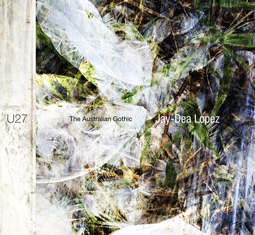Jay-Dea Lopez, "The Australian Gothic"
 On his Sounds Like Noise website, Jay-Dea Lopez expresses concern that the natural sounds found in the northern part of New South Wales, Australia are disappearing. Suburbia, as he puts it, is ever-encroaching and with it has come the suffocating noise of commercialization and technology. That the one will snuff the other out, or damage it irreparably, appears inevitable. Motivated by that threat, Lopez recorded sections of the Main Arm valley in New South Wales, near Mullumbimby at the Queensland border, and used them to compose The Australian Gothic, an album that reproduces some of the unique sounds made by the fauna in that region and, curiously, combines them with man-made noises and rhythms. Without the distortion and the apparently manipulated segments, Gothic would be an audio index of birds, insects, and domesticated animals—a recording of the soon-to-be departed. With them, it’s a more complicated composition, a piece of music that attempts to imitate and preserve nature, but that ultimately integrates it with a touch of its so-called opposite.
On his Sounds Like Noise website, Jay-Dea Lopez expresses concern that the natural sounds found in the northern part of New South Wales, Australia are disappearing. Suburbia, as he puts it, is ever-encroaching and with it has come the suffocating noise of commercialization and technology. That the one will snuff the other out, or damage it irreparably, appears inevitable. Motivated by that threat, Lopez recorded sections of the Main Arm valley in New South Wales, near Mullumbimby at the Queensland border, and used them to compose The Australian Gothic, an album that reproduces some of the unique sounds made by the fauna in that region and, curiously, combines them with man-made noises and rhythms. Without the distortion and the apparently manipulated segments, Gothic would be an audio index of birds, insects, and domesticated animals—a recording of the soon-to-be departed. With them, it’s a more complicated composition, a piece of music that attempts to imitate and preserve nature, but that ultimately integrates it with a touch of its so-called opposite.
The distinction between artifice and nature—often reduced to the human and non-human—is tougher to make than it appears. The first question that comes to mind is are humans natural or are they somehow separate from nature? If the answer is that they are a part of nature, a second question follows, which is whether or not the products of human labor aren’t also natural. This is not the same thing as asking if humans have harmed the environment, but such questions are often conflated because there’s a strong inclination to link what is unnatural to what is harmful, nevermind that the concept of unnatural things might not make any sense. Had Jay-Dea Lopez wanted to preserve what is natural around the Main Arm valley in a simple sense, he might have done everything possible to erase the signs of human activity in the region. The album could have been any number of things: one continuous recording in an established area, a series of recordings from different parts of the valley, or a semi-exhaustive documentary of photos and sounds with track names identifying the variety of noises captured by Lopez’s microphones.
Instead, The Australian Gothic is a single self-titled piece with minimal geographic information attached, accompanied by only a few clear photographs, which depict as many humans as animals. In fact, except for a picture of what might be a cow, the only trace of animal existence in the artwork is an image of white feathers clumped together in the grass, a symbol of humanity’s ever-growing impact on the ecosystem.
Intentional or otherwise, the absence of insects, birds, reptiles, or any other non-human species lends Gothic its ghostly constitution and amplifies the already intense noises Lopez caught during his sessions. Singing crickets and warbling birds figure heavily into the opening, less obvious calls and a more subdued atmosphere follow: frogs, perhaps, and cicadas, as well as bats, monkey-like kookaburras, and other noises that walk on the edge of the animal/mechanical divide. Certain textures could be the product of closely mic’d cattle or of a contact microphone attached to an electric generator. More obviously synthetic sounds snake their way through the mix too, usually in the form of pulsing bass figures or repeating percussive patterns.
The inability to distinguish the one from the other sort of proves Lopez’s point, that the human world is slowly taking over the non-human one, but it also highlights how the two exist together, and how humans imitate their surroundings in surprising ways. If his aim was to emphasize the negative impact of human life on non-human life, then he fails. The link between his subject and his music only begins to solidify once the music ends and a little bit of research begins. With the context in mind, The Australian Gothic still doesn’t portray mechanical noise as the beastly representative of destruction that it may in fact be, at least in certain places. It does, however, catch the place where two worlds cross. Not, as one might expect, natural and unnatural worlds, but visible and invisible worlds, worlds that we take for granted or ignore, or slowly forget as we reproduce our own images and project them more forcefully into places where, surprisingly, we are still aliens.
samples:
 



